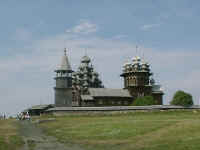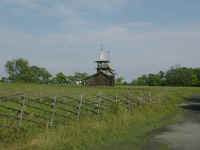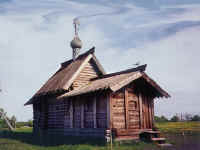 Saturday, 20 July. During the night we had passed through five locks, and when we got up at 7:00, the boat was in the sixth (@km 893), which would lower us into Lake Onega. The total drop in elevation since dinner the evening before was 80 feet. Lake Onega is the second largest lake in Europe. (We would reach the largest one, Lake Ladoga, tomorrow.) Instead of following the south shoreline on the most direct route to St. Petersburg, the Tolstoy sailed north toward Kizhi Island, a detour of about 90 miles each way. After breakfast Jane and I walked around the deck several times for exercise. At 9:30 we heard the Professor's lecture on the "Economical Situation in Present Russia." Marina's third Russian language lesson was at 11:00, followed by lunch. At 1:45 we went to the conference room to watch two short videos on the Romanov family. After that we went to a bliny tasting party in the dining room at 3:00. The bliny (literally, small pancakes) were served with honey and/or caviar. There was also vodka, but we passed on that. Just before 4:00 the Tolstoy reached Kizhi Island. This small island (about 2 1/4 square miles) in Lake Onega is the site of an Architectural Preserve for wooden buildings. Some of the buildings were already here, but others have been brought from other sites. As we sailed by the shore toward the dock, we could see most of the buildings from the boat.
A walking tour of the area began shortly after the boat docked. The largest and most magnificent structure was Transfiguration Cathedral (1714), featuring 22 separate domes covered with aspen shingles. (The number is unusual, both for its size and because Orthodox churches almost always have an odd number of domes.) A large bell tower (1874) separates the Cathedral from the smaller nine-domed Church of the Intercession (1764). There were two surprising architectural features about the large churches. First, they were built without any nails. Second, they, and almost all the other buildings on Kizhi, rest on a foundation of loose stones simply lying on the ground and not held together by mortar. Apparently this design works well in northern Russia where the deep frost would play havoc with rigid footings. Just past the churches we came to a large house built with squared-off logs and trimmed with many decorative features. It had been moved here from another village. The guide said it was a typical peasant's house in its day (1880). She explained that the term "peasant" referred to a farmer, usually with a small tract of his own land. Although to us the term has a connotation of poverty, she indicated that many of them lived very comfortably, making enough money from their surplus crops and farm animals to buy all their necessities, some luxuries, and often additional land. On going through the house, we also discovered that about two-thirds of the interior was really the barn and workshop, so there wasn't as much living space as first appeared. Continuing along the path, we stopped at a small boat house. Then there were some small chapels. One, the Church of the Archangel Michael, had a small bell tower. One of the locals was only too happy to run inside to ring the bells for us (being careful first to put in his earplugs). Next we stopped to examine the small Church of Lazarus' Resurrection (moved here from the Monastery of Murom). This is said to be the oldest wooden structure in Russia, dating from the 14th century. (Our guide allowed as how there was probably nothing that old in the building, since any deteriorating wood would have been replaced as needed and, over a period of several centuries, every original piece had undoubtedly been replaced.) The guide led us back to the Transfiguration Cathedral for a better look now that most of the other tour groups had moved on. As we explored the site, we saw the cemetery where the graves were marked with wooden crosses, each with a sloping "roof" over it. Finally we started back toward the dock. The walking tour had taken more than two hours, and perhaps because of the beautiful weather, we thought it was the most enjoyable single tour of the trip. Although there were a lot of tour groups, it wasn't as bad as most places we'd visited. We learned later that the Cultural Ministry limits the number of visitors to 130,000 a year. Back at the dock, we browsed the vendors' stands and eventually bought a watercolor of the wooden cathedral complex. The Tolstoy sailed from Kizhi Island at 8:00 p.m., just as dinner was served. Afterwards Jane went to a piano concert featuring Musorgsky's music while I read in the library.
Copyright © 2000-2023 DarrellPeck.com All rights
reserved. | |||





